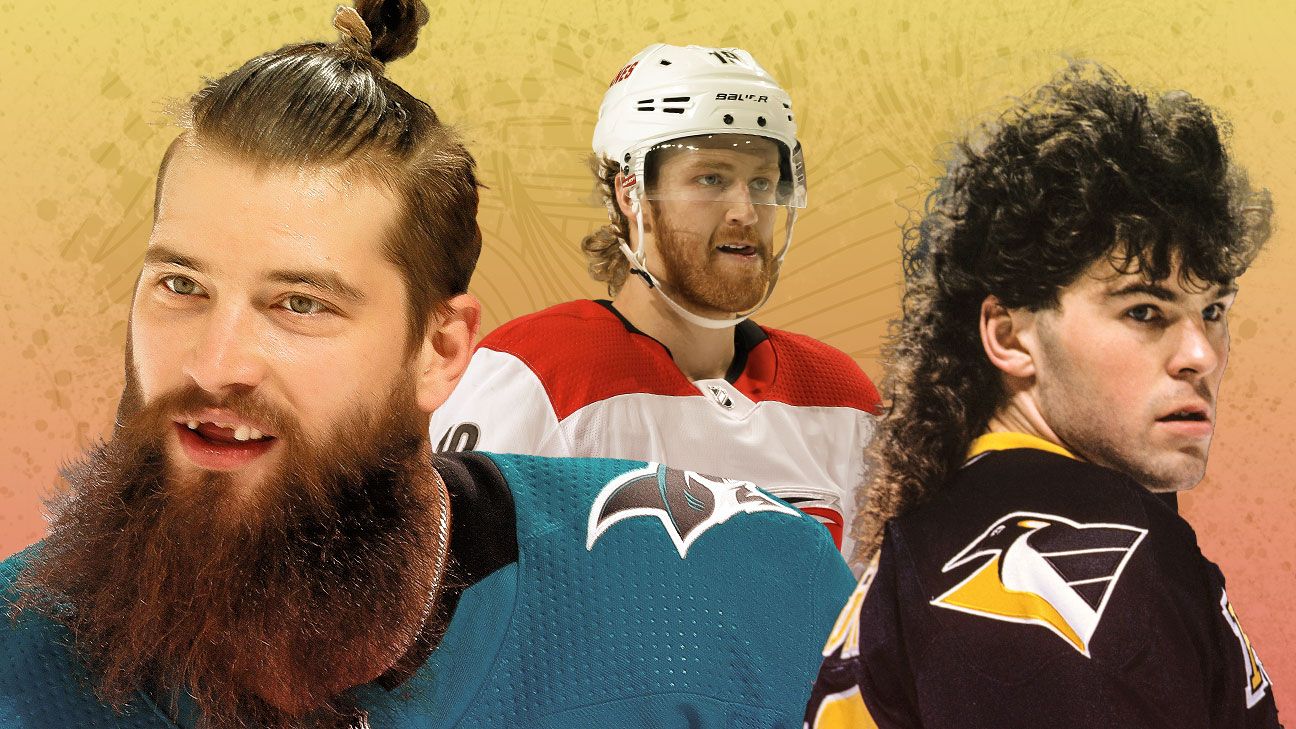In October, Carolina Hurricanes defenseman Dougie Hamilton walked into a barbershop to get a haircut.
“Do you have an appointment?” the receptionist asked. Hamilton did not.
“So I said, ‘Screw it, I’m not getting a haircut,'” Hamilton said. “And that’s how I ended up like this.”
This — the playoff version of Hamilton — is a familiar hockey look: The strawberry blond hair Hamilton has been growing out since October rests in a curly nest down the back of his neck. He has since given his ‘do some upkeep, and the top and sides of his head are cropped.
In pop-culture parlance: It’s business in the front, party in the back. At the rink, it’s yet another mullet.
The hairstyle was rampant in the 1980s, and one of the NHL’s all-time greats, Jaromir Jagr, ushered the cut through the ’90s into the 2000s. Though the style has died down, it’s not quite extinct, with several mullets sprouting up in the league from time to time. This season alone, Hamilton, Buffalo’s Jeff Skinner and Columbus’ Ryan Dzingel have all sported the look.
But hockey culture isn’t just obsessed with the mullet. It’s all hair, really. The NHL fetishizes playoff beards — and the San Jose Sharks‘ roster features two of the most epic bushels of all time, belonging to Brent Burns and Joe Thornton — as well as the teenagers who can only grow peach fuzz. “Flow” is a common term in hockey vernacular. There’s even more niche, hockey-specific words like “lettuce” or “salad” or “chop.” In Minnesota, the high school hockey tournament now doubles as a hair show, with teenagers spending each spring one-upping each other with their locks, and the swagger with which they present them.
“I have no idea what the crazy obsession with hair is about,” says Hurricanes defenseman Jaccob Slavin. “I think hockey players like to have pretty good style. My best guess is, a lot of other leagues show it with their clothes. Hockey players like to do it with their hair — facial hair, or how it’s coming out of their helmet.”
Indeed, compare the NHL to the NBA, which shares the same 82-game schedule and season. When NBA players arrive at the arena, some look like they could be arriving for New York fashion week, with thousands of dollars worth of designer shoes, suits, hats, jewelry and even handbags (though they like to call them dopp kits). In the NHL? Consider when Toronto Maple Leafs star Auston Matthews showed up at an April playoff game with a high-brow look, he was ridiculed on social media.
Anyway, back to the hair. “It’s been going on for a long time, and it definitely feels more prevalent in hockey than other sports,” surmises Washington Capitals defenseman Brooks Orpik. “Now, I think the excuse would be social media. There’s cameras everywhere, so guys are more focused on the way they look.”
Adds Boston Bruins defenseman Torey Krug: “We have to wear a helmet at all times. If the helmet ever falls off, or if we’re away from the rink, we want to be able to express ourselves in some way. That’s how we kind of make our faces known.”
When Columbus Blue Jackets defenseman Markus Nutivaara first arrived in North America from his native Finland, he was shocked to find something in the locker rooms he had never seen before: hair dryers.
“You would be laughed at in Finland if you used one of those,” Nutivaara says. “In Finland, hockey players are more like cavemen. In Sweden, it’s the complete opposite.”
Perhaps the most famous hair in the NHL belongs to a Swede: New York Rangers goalie Henrik Lundqvist. The 37-year-old is known for his perfectly coiffed locks. So much so that he is the spokesperson for Head & Shoulders in Sweden, having done several commercials for the company:
According to Swedish hockey journalist Uffe Bodin, many in Sweden know Lundqvist as much for being “the shampoo guy” as he is for his hockey.
It felt fitting to ask “the shampoo guy” why he believed the mullet fell largely out of favor.
“Like any other trend, it comes and goes,” Lundqvist responded. “It will be back. The question is when.”
There have been touchstone moments for the mullet in hockey history, and one of the most recent examples was when Chicago Blackhawks winger Patrick Kane sported one for his team’s 2010 Stanley Cup run. To this day, high school hockey players in the Chicago area cut their hair into mullets at state tournament time to look like Kane, and many visit Carmelo Preiti, the hairdresser who is responsible for Kane’s cut:
Even tho 88s last mullet was in 2015 SCF Im still receiving high school kids going into hockey playoffs wanting the Kane mullet. It’s great they’re growing the hair long all year to get the kane mullet for playoffs.What a great tradition 88 started for the young ones #mulletmania
— Carmelo (@carmelo_p) February 12, 2019
“Me and Patrick Sharp had talked about doing it for the 2010 playoffs,” Kane says. “After our regular season ended, we both went to get it done. I showed up at the rink the next day with my mullet, and he showed up with his regular haircut — he got it all chopped off. His reasoning was that his dad would be mad at him if he saw him on national TV like that.”
Many credit Kane with reinvigorating the tradition. Explains Bruins defenseman Steven Kampfer: “In 2011, when we were going on a run, we were like, ‘Somebody has to have a mullet because Kane had it last year, so someone has to get it done.'” Then-teammate Shawn Thornton ran a program called Cuts for a Cause and, because defenseman Adam McQuaid was the player on the team with the longest hair, he was sacrificed as the volunteer.
“Across the board, hockey players are pretty superstitions,” Washington Capitals winger T.J. Oshie says. “If it’s something that started back in the day, that’s probably why it’s still here.”
The playoff beard is the biggest example of this. The itchy but celebratory tradition dates back to the New York Islanders‘ dynasty of the early ’80s and has become a fixation in playoff locker rooms ever since.
Non-mulletted long hair is making a comeback, too. (Or really, it never went away.) “Erik Karlsson can pull off the long hair. [Brock Boeser] has the shorter flow, he knows how to maintain it,” Kampfer says. “But then you have some guys and you’re like, ‘Dude, cut your hair.'”
As to how it affects a player on the ice, Kane wondered if the shaved sides of his head would make him more aerodynamic but admitted it wasn’t really the case. Kampfer grew his hair to shoulder-length in junior hockey. It’s a look he very much regrets and cringes when he talks about.
“In juniors, that was the thing. Long hair — that’s when you knew you were a hockey player,” Kampfer says. “When I look at pictures now, I’m like, ‘What was I doing? Why didn’t my parents just take me to the barber?’ When I had my long hair, I thought if I went fast I would kind of be like Mike Modano‘s jersey when he was going — just flapping in the wind. It was kind of like that, I guess.”
Sometimes players change up their hair for attention. Krug says in college, many players “grew out the cul-de-sac on purpose, which was pretty disgusting.” In the first round of these playoffs, much attention was paid to Calgary Flames winger Sam Bennett‘s moustache — which evoked Lanny McDonald’s notorious look.
Of course, not everybody is on board, and the majority of players have generic, close crops. “Some guys care about their hair, the way they look,” Capitals center Evgeny Kuznetsov says. “I don’t really care about it. For me, it’s not about hair. It’s about what’s inside.”
Which brings us back to Hamilton. The Hurricanes defenseman says it took “some rough stages” to get to his eventual mullet, and not everyone was a fan. “I don’t think the guys like it too much,” Hamilton says. “But I’ve gotten some pretty good compliments. A couple girls, like waitresses and people around the arena, have said it’s nice.”
He does have some fans in the locker room.
“I’d never do it,” Slavin says. “But I do think Dougie’s is pretty solid. He has the personality to pull it off. He’s a free spirit.”

